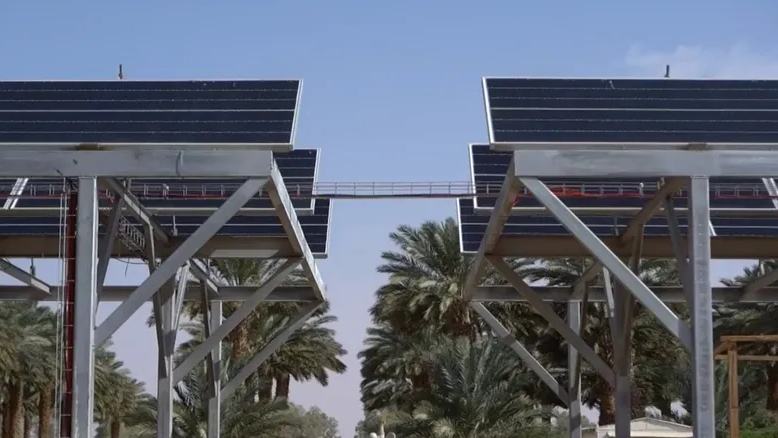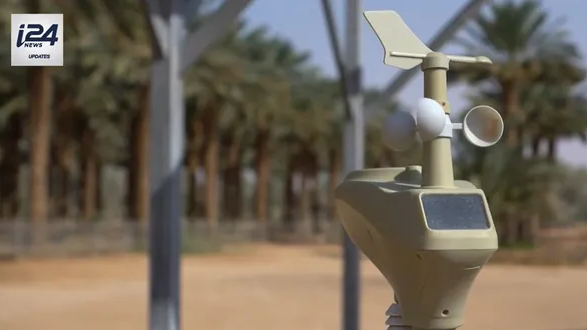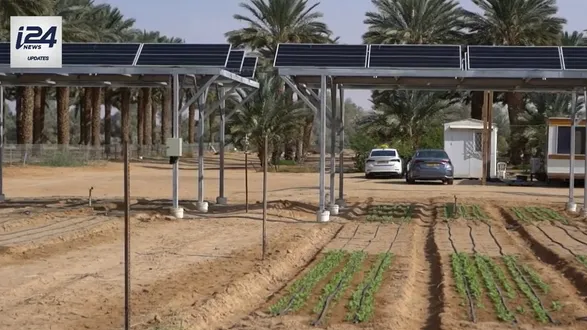Getting your Trinity Audio player ready...
A unique project on a small piece of land in the desert of Israel could be a game-changer in the fight against world hunger and the consequences of climate change.
Surrounded by palm trees, arid land and date farms, this groundbreaking research project has found a way to grow food in desert-like areas, while producing electricity.
After years of development, the project — initiated by the Jewish National Fund USA in cooperation with the University of Arizona and the Kasser Joint Institute — is now being sent to remote places around the world, offering an antidote to the dangers of drought and extreme heat.
The name is "Agrovoltaics" — a combination of the words agriculture and photovoltaic, which just means solar panels.
Harvesting the sun twice
It’s almost like a sustainable self-sufficient toolbox that can be taken anywhere in the world. It allows for crops to grow, while creating its own electricity through the solar panel. That electricity is used for irrigation of the crops — and could even power a house.
Dr. Tali Zohar, lead researcher on the project, explains that the program has grown everything from tomatoes and lettuce to spinach and kale through this new autonomous system. But it has taken time and patience to develop the experiments and turn them into reality, she explains.
“The main idea is to harvest the sun twice…. You’re using the same land for producing food and energy, we don’t have to choose. Now you go around Israel and other places, you have to choose. Either land is used for electricity or for crops. We’re saying let’s do both on the same land.”
The project can be found in different versions in various locations. It has been evolving and expanding for years and this design is just about ready to be taken from the desert in Israel - to the rest of the world, explains Greg Barron-Gafford, Researcher at the University of Arizona.
Supporting local communities
“The benefits from these projects are the local communities," Barron-Gafford says.
"Off grid, whether we’re talking about remote communities in the U.S., indigenous populations, smaller farms, kibbutzim in Israel, communities in Africa. That's where you really see the connection. Largely it’s because in all of these dry land places it's just too hot for crops to produce. In the middle of the day it’s so hot, you can barely look up at the sun. The sun is just too intense, there is no shade. So these solar panels, it is like if you were able to carry a little parasol and offer that protection. In these places that have no food security and bad water security, now you can actually get food, energy and water in the same parcel of land."
One of the main goals of the initiative is to support developing countries around the world. That means taking the research to communities in need - but also to bring students from those countries to learn the skills on-site — and then take them home.
From Israel to Kenya
Ebby Soita and Roselyn Kamau from Kenya are in the process of completing their internship, and for them, the project is very special.
“It’s a system that ensures there’s production of energy at the same time that there’s food security and production of water. Energy from panels can be used to pump water from wells and the same water used to plant crops, and they will provide food. And there will be food security, which is the main problem in Kenya," says Roselyn.
Fifteen percent of Kenya’s 53 million people rely on unimproved water sources like wells, rivers and ponds. And currently more than three million people are severely food insecure after three consecutive failed rainy seasons. A project like this could help change that.
The women are thrilled that they’ve found a way to grow crops in sand. And that they can bring the technical know-how with them back home and actually have a direct impact on rural communities. And potentially save lives.
Soita calls it a “miracle."
Local expertise
According to Talia Tzour, chief of staff of Jewish National Fund USA in Israel, the communities of the Arava desert have become experts in growing and exporting food, like dates, cherry tomatoes and watermelons through years of work and development. But this initiative takes the latest technology to a new level.
“There is aerovoltaic in other places. There are water desalinations, solar panels... But there is no other place in the world where you have all of it together in one holistic approach that you can copy-paste and put somewhere else. That's the importance of the project," she explains.
With climate change becoming an increasingly dire factor in food development and production of clean drinking water, the fund is financing other research initiatives as well.
In dry and hot desert conditions efficiency is crucial for food security. So from one project that took the energy of the sun twice to grow food twice — there are also other projects in the works, including one that uses water to grow food twice.
Aquaponics
Tania Pons, Director of the Kasser Institute, shows us around a greenhouse, where lettuce is growing directly from water using a technique called aquaponics.
“It’s an enclosed system, where you can grow fish and crops. We have tilapia fish — so you can eat them — and then the water from the fish goes to the lettuce. The fish cleans the water, and we can grow kale, tomatoes, leafy greens… So we use water twice. And we hope to install solar panels so we can make it off-grid completely. It’s a holistic system.," she says. Just like the first system.
Tania explains that they’re also looking for alternative ways to feed the fish, to bring the cost down and make the whole process independent and disconnected.
Once again this is all done just by using what nature already offers in the most effective way possible. With the goal to help feed tens of thousands of people around the world in a sustainable way.




